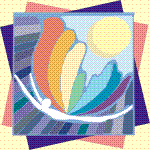Tips for Organizing Everyday Things with Adult ADD
Life with ADD (or ADHD) can be a constant hassle. Little things like lost car keys, tools that stick or don't cut well, papers that go missing all add to the general level of tension. These how-to tips will help you come to grips with the nitty-gritty of everyday things.
- Things have a place close to where they are used.
Putting things close to where they are used means that you do not have to move away from your work space to find them. Car keys are a good example of things that go missing; have a place, a basket or a hook, near the door where you come in and go out. Train yourself to put them there every time you come in.

I have two pairs of scissors in the kitchen. One is short and works well to open packages of food; it lives in a drawer by the stove where I cook. The second pair, longer, lives on the kitchen table where I read the newspaper and often cut out articles. I used to have only the long pair for everything, but it was never where I wanted it. Now which ever pair I need is right at my finger tips.
- The place for a thing should be logical to you.
Give some thought to when and where you use an object and store it near by. Don't worry about what other people might think. You are the one who is using it. If someone else also uses the object you may have to negotiate or better yet buy two.
I keep paper clips over the bread board. Why? I use paper clips to close up bags of cereal and nuts which stay in the same cupboard; I rarely use them for attaching papers together, and when I do, I know where they are.
- Have tools which are efficient to use and feel good.
A letter open that is long enough to open an envelope with one or two strokes. A paper punch which will take a wadge of papers in one go. Scissors which are sharp and feel good in your hand. Good tools make a job easier and quicker to do and help to avoid tension.
I had two letter openers. One, short, stubby,and now gone, was difficult to insert into the envelope, took two or three hacks to get the envelope open and the handle was too short to grasp comfortably. The other has a longer blade which slips easily into the open space in the envelope and the handle fits comfortably into the palm of my hand. Opening the mail is quickly done.
- Use containers that are adequate and pleasing to you.
Containers should be large enough to hold whatever they are designated for and should hold only one category of thing: a colored envelope on a convenient shelf for bills to be paid this month, an attractive basket by the front door for your keys.
I needed something to hold pencils, scissors etc on my desk. I looked in several stores; they all had versions of a stack of chimneys. I reasoned that they weren't adequate and kept looking. I found an organizer in the shape of a dog in my favorite color; I didn't even stop to think if it was "adequate". He does his job admirably and I use him because he's cute.
- Put things away when you are finished using them.
When things live close to your work space it is easy to put them away immediately. Putting them away becomes part of the task in which they were used instead of a separate activity called "putting away". As people with ADD have difficulty coping with multiple tasks, eliminating even one makes every day living a little bit easier.
- Now to organize everyday tasks - create a routine : the 5 minute SWOOP.
Routines? Sound boring? Yes routines help you get the boring things done without thinking about how boring they are. The 5-minute swoop is designed to do the basic everyday tasks in each room. Make one list for each room of the things that need to be tidied up everyday. Spend no more than 5 minutes in each room; set a timer if necessary. You will know how much time you are going to spend before starting therefore you can get out the door in time to get the kids to school or to your meeting. Be strict about the 5 minutes so that you don't get captured by the impulse to organize an entire cupboard.
Still can't seem to tame the monster? email me today.
You will find more helpful tips and ideas in my free newletter Zebra Stripes, subscribe now.